Early history.
Early History
INDEX
.
BEGINNING OF EUROPEAN SETTLEMENT
In the half century following its foundation in 1829, the government of the Swan River Colony could not convince the Peninsular and Oriental Steam Navigation Company (P&O) that Fremantle was a more viable port than Albany in the south. Though C. Y. O’Connor was to prove them wrong less than 10-years later, the experts of the time said that a suitable harbour in Fremantle, if constructed, would need constant dredging and was thus impractical to build. They suggested a better use of the governments meagre funds would be a railway that connected Perth to Albany.
A New South Welshman, Sir Anthony Hordern, applied for, and obtained, the contract to build the railway on a land grant system after he created the Western Australian Land Company in London specifically for the purpose.
On October 20th, 1886, Sir Frederick Broome turned the first sod on the construction of the Great Southern Railway in Albany, while his wife, Lady Broome, did the same thing nearly 400 kilometres away in the town of Beverley. This set-to-work two construction crews and their travelling villages that would converge, two years and four months later, at a spot four kilometres north of what is now the town of Katanning. Continue reading
.
EARLY TOWN SETTLEMENT
Katanning was declared a town on June 10, 1898 by Commissioner of Crown Lands, George Throssell when blocks of land were made available for sale. Continue reading
KATANNING – Capital of the Lower Great Southern
The Blue-wool Country Farming Lands of Katanning
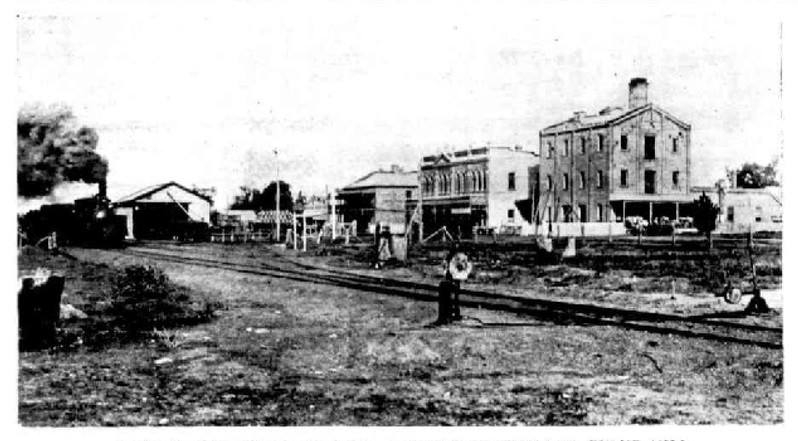
Katanning and the Premier Roller Flour Mill c1905
From “The Western Mail” – Perth
4 November 1937
PERHAPS someday there will be erected a monument to the State’s early shepherds, those intrepid yet nameless men, ever pushing onward in search of fresh pastures, who pioneered some of the State’s finest farming lands.
It was nearly 100 years ago that shepherds, exploring north from King George’s Sound and south from the Avon Valley, discovered the grazing lands of the lower Great Southern, the country around Katanning, Woodanilling, Broomehill, Cartmeticup and Marracoonda, which has come to be a sheep and wool area unsurpassed in the State.
During the whole of the State’s agricultural history the lower Great Southern has never had a drought. Even in 1914, which is still quoted by farmers as the State’s record dry year, Katanning received 16 inches. With such an assured rainfall, it is only natural that Katanning should have an enviable reputation for safe farming.
Although the State’s sheep industry dates back to the earliest years of settlement, it is only within the last 30 years that stud breeding has made rapid growth. It was in the Katanning-Broomehill-Gnowangerup area that the earliest Merino studs were founded, and this has now become recognised as the foremost stud district of the State.
Since the early days, settlement has extended steadily east and west of the Great Southern Railway, and today Katanning is a centre with varied farming interests. From the East, the country around Badgebup, Nyabing, Pingrup and Gnowangerup, come train loads of wheat; from the west, out Kojonup way, come the great blue-wool clips of the State. In the past two or three years there has risen another industry, fat lamb raising.
With an assured rainfall, top-dressed pastures and treatment works within easy distance at Albany, this promises to become one of the major industries of the lower Great Southern.
THE EXPLORERS
WITH the State’s earliest settlement established at King George’s Sound and the Swan River and the opening of an overland route between these points, the Great Southern was one of the first parts of the State to be explored by the British. It is recorded that Captain Bannister, early in 1831, made the first expedition overland from Perth to King George Sound, his route being via York and Williams, the town of Albany, as such, being proclaimed on his arrival at the southern port.
His report of the country south of Williams was not favourable, the chief aim of explorers in those early days, and for many years afterwards, being to locate open, well-grassed and naturally watered areas suitable for the depasturing of stock. It was this aspect of settlement that accounted for the apparent neglect for many years of the more heavily timbered areas of the Great Southern.
It was in 1834 that Sir Richard Spencer, Government Resident at Albany from 1834 until his death in 1839, obtained 292 sheep from Tasmania. This flock was at first depastured in the vicinity of Albany, but in the year following, 1835, was moved to a property on the Hay River, which Sir Richard had acquired from the Crown.
At this period, the whole of the country in the vicinity of Albany and extending as far north as Eticup (Broomehill) was part of the Plantagenet district, the Williams district, later being declared by Surveyor Hillman, in 1835, when he traversed and marked the Hotham and Williams rivers.
In 1838, Captain John Hassell, a seafaring man and the founder in Western Australia of the Hassell family, acquired land in the Mt. Barker district, this property of 20,000 acres being named Kendenup. Some years later, Captain Hassell extended his activities to Jarramungup, where he acquired a large pastoral property.
The first mention of Kojonup is in 1837, when Surveyor Hillman and Dr. Harris explored the country in the vicinity of the present township of Kojonup, the locality receiving its name from a spring of fresh water where they camped.
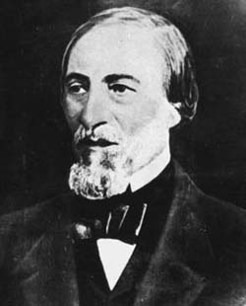
John Septimus Roe
Eleven years later, in 1848, Surveyor-General, J. S. Roe, starting from York, explored the country southward to Cape Riche, his route being to the eastward of the present Great Southern railway. Reaching the coast, he turned eastwards, traversing and naming the Pallinup, Gardiner, Fitzgerald and Phillips Rivers. He located large areas of sandalwood on this expedition, and this discovery hastened the opening up of the Great Southern.
It was in this year, 1848, that the survey of the Perth-Albany road was completed, although the actual clearing of the surveyed line was not commenced until 1850. The history of the Perth-Albany road may be said to have commenced when Captain Bannister, in 1831, set out from York to mark a route, to King George Sound. Following his report of the land traversed, particularly in the vicinity of Mt. Barker (located and named by J. B. Wilson in 1829), Sir Richard Spencer extended his acquisition of land to a property five miles west of Mt. Barker.
In 1836, Surveyor Hillman marked a road from Albany to Mt. Barker, this survey including an extension to Lake Matilda. In July, 1837, a track was cleared from Albany to York, via Williams, and military posts were established along its length to protect travellers from natives. In 1838, the year that Captain John Hassell acquired Kendenup, it is recorded that four bridges were constructed on this length of road by John Young, and in 1841 a monthly mail was established between Albany and York. In the same year a more direct route from Williams to Perth was opened up, and a military post established at the Bannister, named after Captain Bannister, who had first marked this route. Read more
SOLDIER SETTLERS
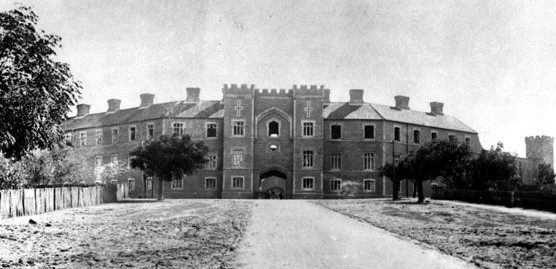
Pensioner Guard barracks in Perth c1895
Following the survey of the route in 1848 and with the arrival of convicts from England, the direct road from Perth to Albany was cleared, as were roads from Perth to Northam and York, and from York to Williams, thus giving access between the then only settled portions of the whole State.

Elverd House, a pensioner guard’s home in Kojonup.
To guard the convicts on roadwork, military depots were established at Kojonup, Arthur, Williams, Bannister and elsewhere, the soldiers being recruited from time-expired men of the British army, mostly from India. These pensioners were made grants of land to induce them to stay in the colony, and thus became pioneer settlers. In the Kojonup district today, such well known families as those of Norrish, Elverd. Riley, Bagg, Newstead, Forsythe, Tunney, Noonan, Jones and others were established in this manner, descendants of their soldier forbears.
Whilst the history of the Perth-Albany road was still in the making, settlement, from Albany was gradually extending northwards. Lieutenant Egerton Warburton, a son-in-law of Sir Richard Spencer, in 1839 acquired the property of St. Werburgh, west of Mt. Barker, which still remains with the family.
Edward May Spencer, a son of Sir Richard, who had worked his father’s Hay and Mt. Barker properties, extended further out on the death of his father, and records show that in 1840 he was the registered owner of land at Eticup, his holding including at least portion of the old Goblup estate. On his death, in 1867, he left this land to be divided between his niece, afterwards Lady Cockburn Campbell, wife of Sir Alexander Campbell, Government Resident at Albany, and his nephew, Joseph Spencer, father of Mr. R. L. Spencer, of Kojonup.
The first residence on Goblup was built by Lady Cockburn Campbell in 1873, and was in use when the property was purchased by Lord Brassey in 1888,” and, later, when Messrs. Tom and Ross Anderson became owners in 1903.
MAIL ROUTE
The records of the State from its commencement contain many interesting references to this main artery of communication between the widely separated points of settlement at Albany and Perth. Dr. Harris, who subsequently settled at Williams, has left on record his impressions of the journeys he made over the route.
It was on February 21, 1837, that he, accompanied by Surveyor Hillman, Lieut. Armstrong and a detachment of the 24th Regiment, left King George Sound for the Williams, arriving at his destination 12 days later. He then set out for Perth, via York, the whole journey taking 24 days. He described Kojonup as being the centre of some of the most fertile land he had seen since his advent to the country.
The object of this particular journey was to investigate for the establishment of military stations for the protection of the overland mail then under consideration. On May 4, 1837, a notice was issued by the Colonial Secretary’s office, appointing Lieut. Armstrong to a military depot at Kojonup, with jurisdiction over an intermediate station at Mt. Barker, military posts already having been established at Williams and York.
In June, 1837, reference is made by Dr. Harris to the first overseas mail being carried by foot from Albany to Perth. The volume of traffic between Albany and Perth was fast increasing, and the original pack-horse delivery between the two settlements was discontinued in December, 1841, when the Government inaugurated a mail service by means of a spring cart, 15 days being allowed for the trip, each way.
FIRST SURVEYS
It was in May, 1840, that the first surveys were made in the Kojonup district, Surveyor Hillman, accompanied by Assistant Surveyors Gregory, Saw and Phelps, marking 22 blocks, containing 22,324 acres in all. By 1846, only 17 further blocks, containing 27,068 acres, had been surveyed, and the one hundredth block was not marked until October, 1879.
Amongst those, who obtained land in the first surveys, and whose descendants are still in the district, were Richard Norrish; Warkalup, Kojonup; Elizabeth Jones, Kojonup; Elijah Quartermaine, Yowangup, Katanning; Edward May Spencer, Eticup, Broomehill; Lieut. Geo. Warburton, Kojonup; A. Newstead, Kojonup; Jos. Spencer, Balgarup, Kojonup; A. Forsythe, Kojonup; J. Hassell, Kendenup; and Edward Treasure, Martinup, East Broomehill.
The earliest settler in the district, then generally known as the Kojonup district, apart from those connected with the military post at the town of Kojonup, was Edward May Spencer, son of Sir Richard Spencer, R.N., K.H., C.B., Government Resident at Albany. Edward May Spencer is recorded as being the owner of Kojonup Location 12, containing 10 acres, Location 26, containing 15 acres, and Location 38, containing 100 acres, granted and surveyed in 1840, and situated on the Gordon River, in the vicinity of Eticup, a few miles west; of Broomehill.
The only landholder in the vicinity of Eticup was a settler named Solomon Drolf, who was the registered owner, of Locations 27 and 36, totalling 70 acres. Joseph Spencer, nephew of Edward May Spencer, situated at Balgarup, on the Perth-Albany road, was the only other settler near Kojonup for many years, the three forming the vanguard of the pioneer sheepmen in the Great Southern who had entered from the south.
To the north, however, Elijah Quartermaine, who left England in 1830 with his family to try his fortune in the new world, had taken a small block at Yowangup Spring, purely as a sheep camp, and for the next 20 years, until 1860, was content to travel flocks of sheep yearly from Beverley southward, lambing at Yowangup and returning to Beverley for the shearing.
THE SANDALWOOD CUTTERS
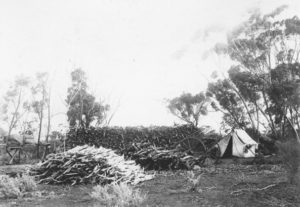
Sandalwood Harvest c 1890s
Records show that for the period 1840-1880 practically no further settlement took place in the vast expanse of country from the Perth-Albany road eastwards. Following the discovery by Surveyor-General J. S. Roe, in 1848, of sandalwood in this country, a number of men ventured out into the unmarked territory sandalwood cutting, Eticup being the centre of the industry.
By this time there was a horse-pad, unsurveyed and winding from settler to settler in that isolated waste, reaching from Beverley to Mt. Barker touching in its windings, Yowangup Spring, Catanup Pool (now Katanning), Eticup, and on down the Gordon River to Lake Matilda and Mt. Barker, eventually reaching Albany.This track became the highway of the Great Southern and all the adventurers of those days took the track as an alternative to the better known, from an historical standpoint, Perth-Albany road.
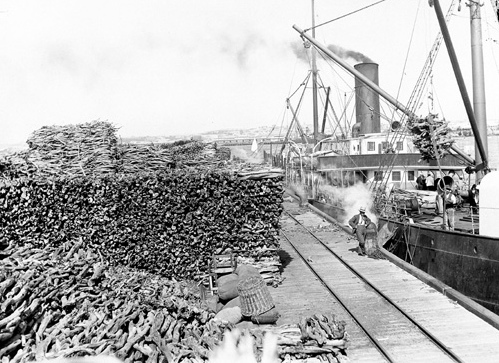
Sandalwood stacked at Fremantle Harbour ready for export to possibly China – 1905
A third route through the south-western portion of the State was also opened, the track reaching down from Perth along the coast to the Vasse, thence across country via Hesters to Kojonup, and it was along these three routes that the first land settlement took place.
It has been said that the advent of sandalwood brought men into the district for the purpose of cutting this valuable timber. Another, and earlier, channel for exploration, however, was the fact that all the early pioneers of the district subsisted almost entirely on their flocks and, as practically no clearing had been attempted, the procedure was to send out shepherds with flocks of sheep, who returned to their employers yearly at shearing time.
These old sheepmen were always seeking fresh pastures and, whenever their shepherds found good water in grass country, applied for the land surrounding the springs or pools, in ten, twenty, or thirty acre blocks. In this manner, as the years progressed, small blocks were taken up through the country, survey following as opportunity permitted. The shepherds, following the example of their employers, also took land, and so it was that William Jones, originator of the Kojonup family, Edward Treasure, who selected at Martinup, Michael and John Cronin and many others became established as farmers.
FIRST SETTLERS
It has been recounted that Elijah Quartermaine, following his sheep as they sought new pastures, came from Beverley to Yowangup in 1840, for 20 years afterwards making the yearly pilgrimage to Beverley for shearing. Then, in I860, he left the open road to make his home permanently at Yowangup. Close on his heels came others, and his home was still new when Tom Haddleton came to Coompatine and Andrews to Moojepin.
Official recognition was given to the settlement to the east of the Perth-Albany road in 1861, when Sergeant McKenna, with his wife and family, was appointed the first trooper to the district, the police camp being at the pools now known as the Police Pools. About this time Richard Bell came to the district, shepherding sheep from Hester, but he did not make his permanent home in the district until many years later. In 1865, Sergeant McKenna was relieved, Sergeant William Grover taking his place, bringing with him a young wife and two babies. Four years later, William Grover resigned, to take up Indinup, the property the family still owns.
In 1870 there were very few families resident in the district, as distinct from sandalwooders and kangaroo hunters, namely the Quartermaines’, Haddletons’, Andrews’, Grovers’ and Cronins’, in the vicinity of Katanning; Trimmer and Graham, at Eticup, the Treasures at Martinup, and Richard Norrish, Joseph Spencer, the Jones, Elverds, Baggs and a few others at Kojonup.
During the next ten years, 1870-1880, only fifty new blocks were surveyed to the district, many of these being additional areas taken by the original settlers. Amongst the newcomers during this period were the Annices’, Alex Moir and Pat Garrity, in the vicinity of Broomehill, and Michael Fahey, at Gracefield, on the Perth-Albany-road. This latter holding subsequently was acquired by James Tunney, son of Sergeant Tunney, of Albany, and is still held by the Tunney family.
COMING OF THE RAILWAY
In 1880 there were practically no railways in the State, but from then onwards a persistent policy of railway construction was entered upon by the Government. By 1884 the railway which eventually became the Great Southern had reached Beverley, and in that year the tender of Anthony Hordern, of Sydney, was accepted to construct the line from Albany to Beverley. The line was commenced in the beginning of 1889, the actual linking up taking place at Katanning, which thereby received its first impetus.
It was in this year that the fortunes of the Piesse family became linked with Katanning, for the two brothers, Frederick and Charles Piesse, who had followed the construction gangs as storekeepers, determined to remain at Katanning after the completion of the line.
It was after the opening of the railway on June 1, 1889, that the great forward move of the district began, when the tide of settlement became too great for individual reference.
HISTORY OF KATANNING
Up to 1929
In 1929, to celebrate Australia’s centenary, the Great Southern Herald (Katanning’s oldest surviving business) produced a 68 page publication “Katanning and Districts 1929 Centenary Publication (Illustrated)”. The publication provides a wealth of knowledge about the early days of Katanning and its settlement. The following information has been sourced from that publication. All measurements and monetary values have remained as they appeared in the publication.
SETTLEMENT
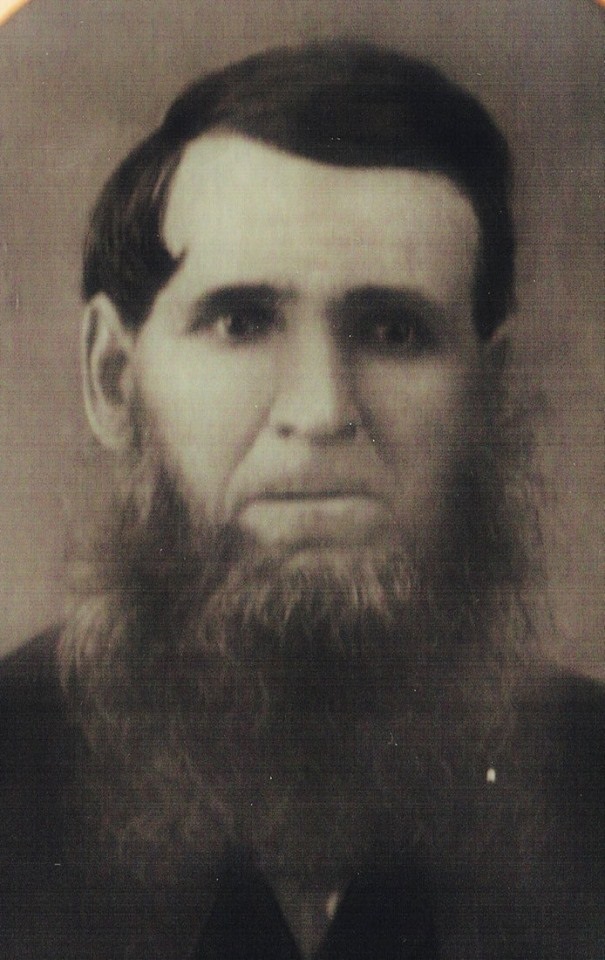
Elijah Quartermaine
Katanning’s first white settler.
It has been determined that Elijah Quartermaine, following his sheep as they sought new pastures. came from Beverley southward to Yowangup in 1840. For twenty years he followed this route yearly, returning to Beverley at shearing time, his sons, as they grew to adolescence, helping the old pastoralist with his flocks. But the track became a highway, and settlement following its course, Elijah Quartermaine in 1860 left the open road to make his home with his family at Yowangup.
Close on his heels came others, and his home was still new when Tom Haddleton came to Coompatine, and Andrews to Moojepin.
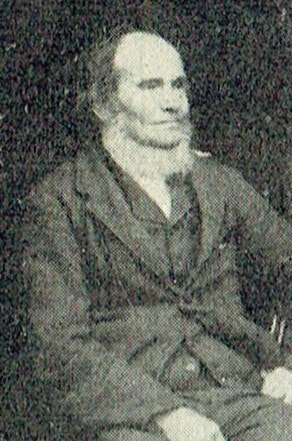
Tom Haddleton
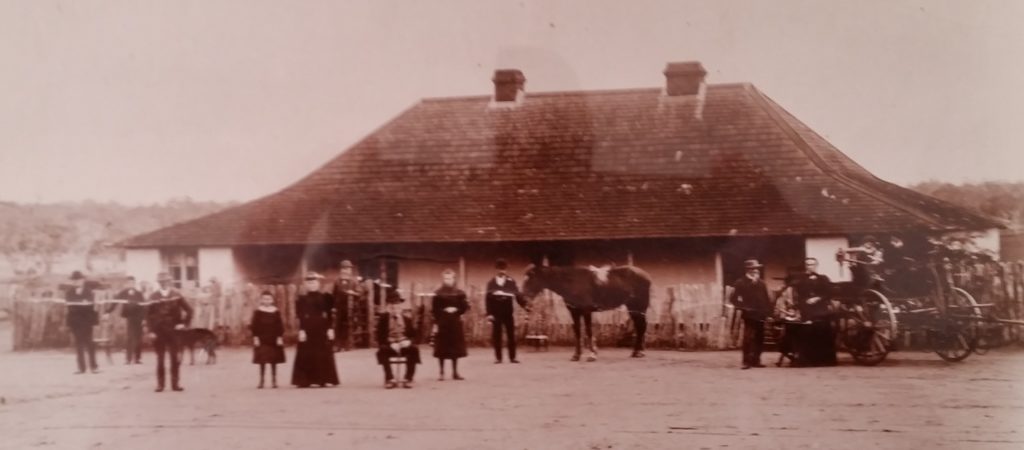
“COOMPATINE”
The original farm house built on the Haddleton family farm in 1870. This photograph was taken in 1890 and features Mr and Mrs Tom Haddleton Senior (by the buggy) and Sergeant McKenna, the first police officer stationed in the district. Sgt McKenna had set up camp at “Twontquillinup” (the Place of Frogs). The area is now referred to as “Police Pools” and a memorial has been erected to mark the site.
RAILWAYS
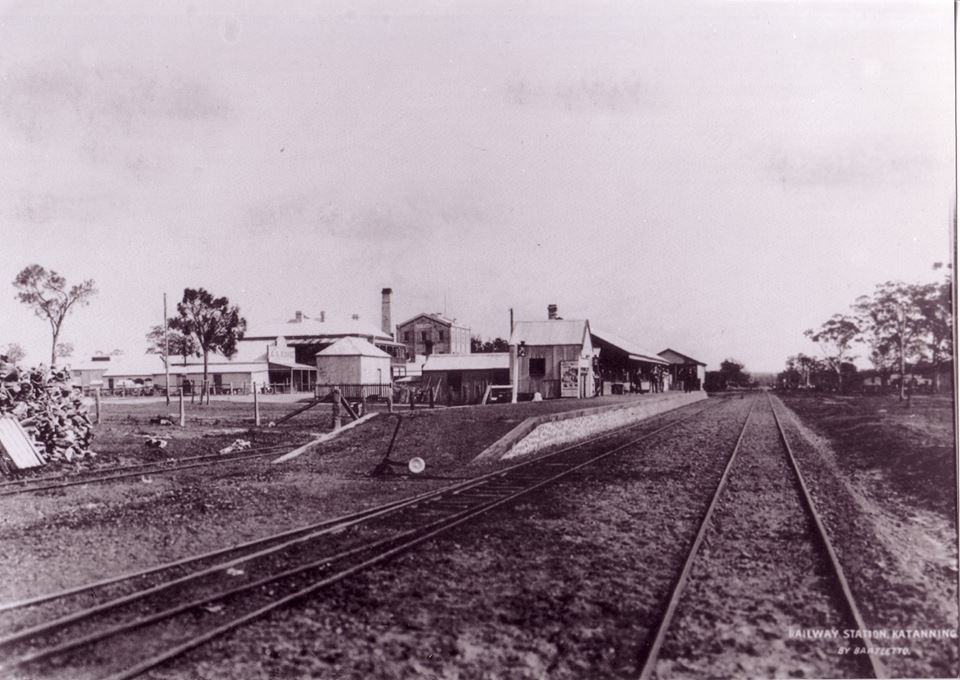
Katanning Railway Station c1900
In 1880 the only railway operating in the State was, apart from short lengths privately owned in the timber concessions, the Geraldton-Northampton line. The Fremantle to Guildford line was not constructed until 1881. With the rush of gold-seekers however, the Government instituted a policy of railway construction, and within the next six years the railway system included lines from Perth to Beverley, Spencer’s Brook to Northam, and Clackline to Newcastle (Toodyay).
A railway to connect Albany with the terminal of the Eastern railway was mooted in 1880, but it was not until 1884 that a concrete proposal, put forward by Anthony Hordern, of Sydney, to construct the railway on the land grant system, was accepted.
The contract, which was signed on 25th October, 1884, entitled the syndicate represented by Mr. Hordern to 2,916,000 acres of land along the route of the 243 miles of railway connecting Albany with Beverley, the land being granted in alternate blocks, 60,000 acres in area. A further offer from Mr. Hordern to build a tramway to connect Fremantle, Bunbury, Busselton and Kojonup was rejected.
In order to carry out his agreement to build the Great Southern Railway, Mr. Hordern formed in London the Western Australian Land Company, with a capital of £300,000 and a debenture issue of £500,000. Mr. Hordern was returning to this State to organise operations, but died on the voyage out. His control was transferred to the Western Australian Land Company, the work of construction being in the hands of Millar Brothers, of Melbourne, who commenced at both ends and proceeded so rapidly that the line was opened to traffic on June 1, 1889.
The actual junction of construction was at Katanning, which thereby received its first impetus. The township was declared shortly after the completion of the line, as were those of Mt. Barker, Cranbrook, Broomehill, Wagin, Narrogin and Pingelly.
The company was under an obligation to introduce 5,000 immigrants within five years from the commencement of the railway, receiving £10 for every adult so introduced, and actually did bring a number in 1886 and 1887, but asked to be released from the obligation owing to its inability to place any more on the land. One of the conditions entered into by the Government in connection with the building of the line was that it would withdraw from sale, for a period of eight years, all unalienated land within ten miles of the railway.
This proviso gave the Land Company a monopoly over the sale of land; but so little use was made of it that very little settlement took place whilst the control of land along the Great Southern Railway remained in its hands. The position was altered in 1896, when the Government decided to purchase from the Western Australian Land Company the whole of its interests in the railway and land concessions.
The late Hon. F. H. Piesse, who was at that time Commissioner for Railways, a Ministerial appointment in the Forrest administration equivalent to Minister for Railways, undoubtedly exercised a great influence in this matter. His intimate knowledge of the Great Southern districts and his unwavering belief in their potentialities assisting the Government to form its decision.
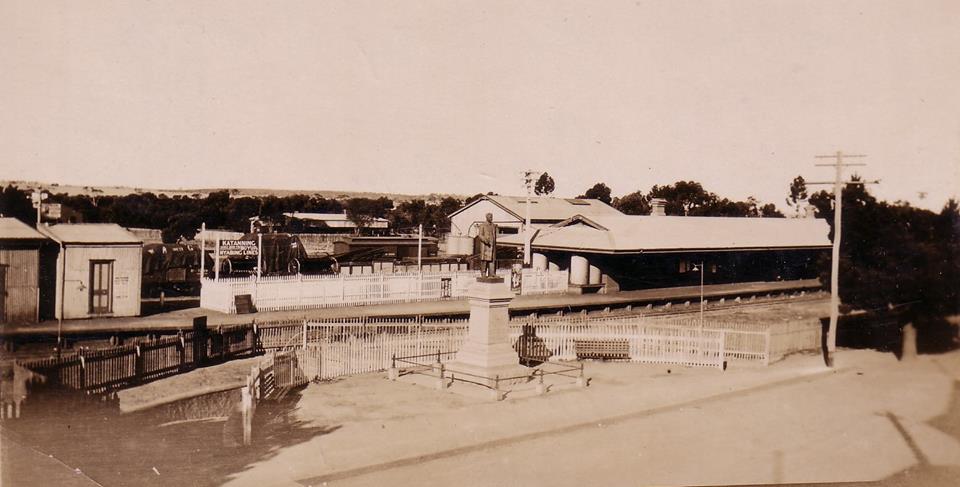
The railway station with the old goods shed in the background and the pedestrian underpass in the foreground c1940
THE FORWARD MOVE
The forward move of the district may be said to have commenced with the purchase by the Government of the Great Southern Railway although from 1890 onwards a steady, but very slow, stream of settlement set in. In 1890, the year Mr. Tom Garstone came to the district, he, F. H. Piesse, F. T. F. Crosby, J. H. Newton and J. C. Jennings were amongst the first to purchase land from the WA Land Company.
At that time there were five families only settled on their properties namely the Quartermaine’s, at Yowangup, Marracoonda, Boyaminning, Mean Mahn and Woolcobinning; the Haddleton’s at Coompatine; the Grover’s at Indinup; the Andrew’s at Moojepin; and the Cronin’s at Glencoe, all in the vicinity of Katanning.
Another small settlement had taken root at Eticup where the Norrishs‘, at “Goblup“, Grahams’, at “Fairfield”, and Garritys‘ at Eticup and Greenhills. Armstrong, W. P. Wray, T. McGuire, Nelsons’, Annices and a very few others were an oasis in a wide expanse of virgin country. Tambellup existed only as “Tamballarup”, the homestead of Joseph Norrish, the halfway house between Eticup and “Gracefield”, the home of the Tunneys’. At Kojonup there was a definitely established township, with a number of settlers of many years standing in the near vicinity.
“Quanandrup”, on the outskirts of the town, was then the property of Mr. Louis Vanzuilecom, his home being at Yeneyellup, on the Bridgetown road. “Warkalup” was the home of the Norrishes; “Balgarrup” was held by Mr. Joseph Spencer and was later purchased by his nephew, Mr. A. E. Warburton; Mr. R. L. Spencer held “Black Forest”; the Jones family were in business in Kojonup, and had large landed interests in the vicinity of the town.
In addition to these settlers were such families as Bagg, Elverd, Forsythe, Watts, Krakouer, Treasures’ and Flanagans’, chiefly descendants from those of the old soldiering days. The Cornwalls’ were established both at Kojonup and the Beaufort. Very shortly afterwards, however, the empty spaces began to fill with Richard Bell and family, Wm. Pemble, Patterson’s, Baker, McLeod, the Beeck family, Prosser’s, Wilhelms’ and Severin’s all arriving in the early ’90’s. Settlement spread eastwards, pioneered by the Warren family, at Dyliabing in 1898, followed by the Caldwell’s, and from this onward it would be impossible to detail the tide of settlement.
FOUNDATIONS OF KATANNING
Long before the Great Southern Railway was thought of, sandalwood cutters had penetrated the uncharted country lying between Albany and York. Their drays, leading from water to water, formed the first roads of the district. Such a track wound its way northwards from the York Road at the Round Swamp, Tenterden, following a route which was to be taken, 50 years later by the railway, through Tamballarup and Eticup to the Quartermaine homestead at Yowangup Spring, thence northward to York.
Midway between Eticup and Yowangup was a clear pool of sweet water, named by the natives “Kartanup“, and from this pool, which is in the bed of the creek passing through the Katanning Park, now filled with sand and serving as a playground in the summer for the children of the present generation, did the town of Katanning receive its name (conjecture – ed.).
The Great Southern Railway, which was commenced in 1884 from Albany and Beverley simultaneously, was finished in 1889 by the junction of the two ends in the vicinity of Kartanup Pool, and when the townsite was declared it was named Katanning. As the work of railway construction progressed, it was followed from the north by the Piesse brothers (Fredrick and Charles) and from the south by Hugh Climie, who supplied the men with stores, the two meeting and remaining at the terminal point as rivals in the store-keeping business. These stores formed the nucleus of the new town.
The fact that Katanning was made the crossing point of the north and south bound trains added further importance to the little settlement, and necessitating a hotel (Katanning Hotel), built by F. H. Piesse. First under canvas, but later in wood and iron buildings, the business of the town grew, and by 1890 six permanent structures had been erected, the railway station, Piesse’s store, the hotel, with Harry Chipper as licensee, Climie’s store, Richard Bell’s boarding house, and F. H. Piesse’s residence.
With the completion of the railway, settlement commenced, and in 1891 the Great Southern Agricultural Society, the parent body of the Katanning Agricultural Society, was founded, with its centre at Broomehill.
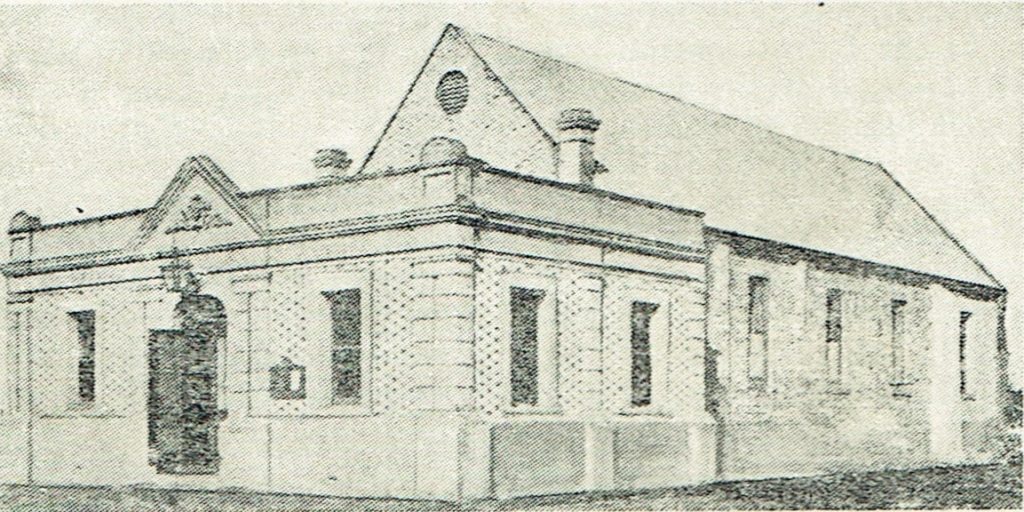
Mechanics Institute c1896
The Mechanics Institute was built in 1896, to be superseded in 1905 by the first Town Hall, this in its turn being re-built and enlarged in 1928.
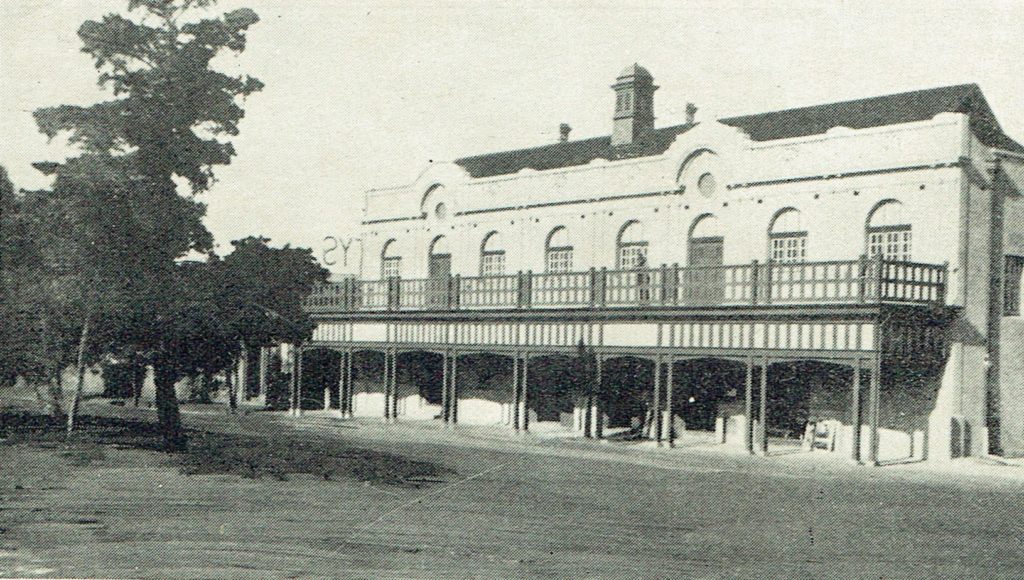
Katanning Town Hall c1925
Mr. Wm. Pemble arrived about this time, and commenced business as a general agent. In 1891 the Katanning Flour Mill was built by F. H. Piesse, trading as F. and C. Piesse, and H. Climie having been bought out, a new and larger store was built.
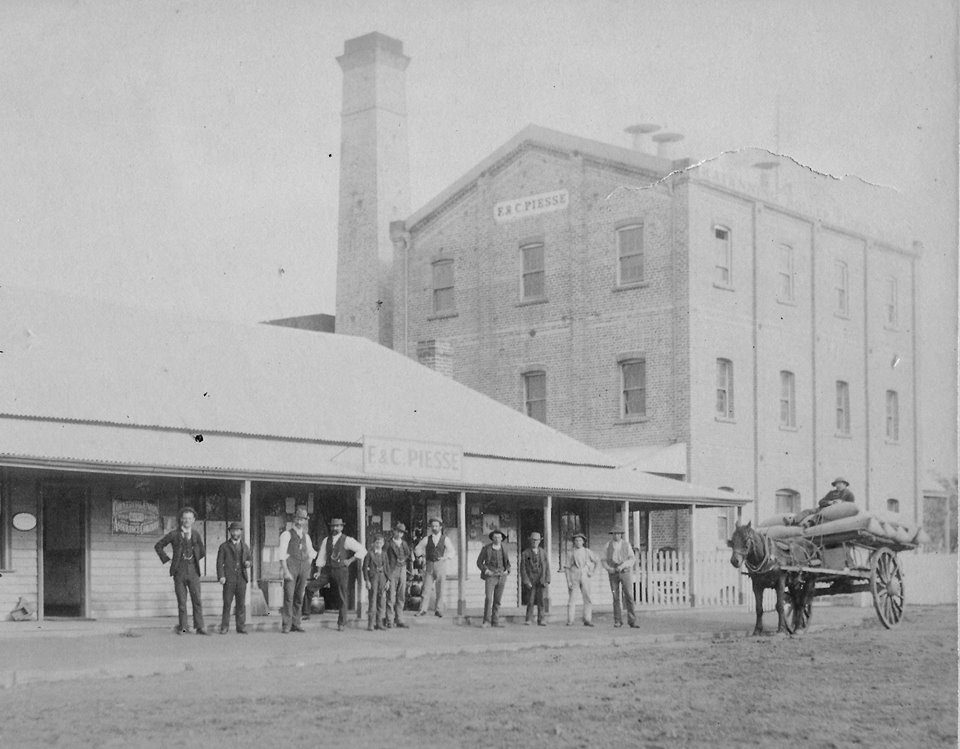
The ‘new’ F & C Piesse store alongside their mill c1891
This store, still of wood and iron, occupied the site where Richardson and Co.’s fine premises now stand, and in its day filled many purposes. The first bank, the National Bank of Australia Ltd., used portion for banking purposes; the first post-office was opened there, with G. A. Piesse as first postmaster, and in turn it was called upon to serve as Court House, or church or Hall as the occasion demanded.
The Katanning Road Board was declared in 1892, the first school was opened in 1893, Miss Mary Bell, now Mrs. Pittelkow, being the first teacher, and in 1894 the Court House, the old Hospital and the first Government Post Office were erected.
The first medical practitioner, Dr. F. M. House, commenced practice in 1894, but left for the North-West to be Resident Medical Officer and Resident Magistrate in the Kimberleys’ until 1901, when he returned, and was appointed R.M.O. and R.M. to these districts, taking the place of Mr. W. K. Adam, who had been appointed the first Resident Magistrate. Mr. C. A. Harris, who arrived in 1896, was the first baker, afterwards adding general store-keeping to his activities. This portion of the business being sold in 1901 to Mr. Rogers, who later formed it into a company as Rogers Ltd.
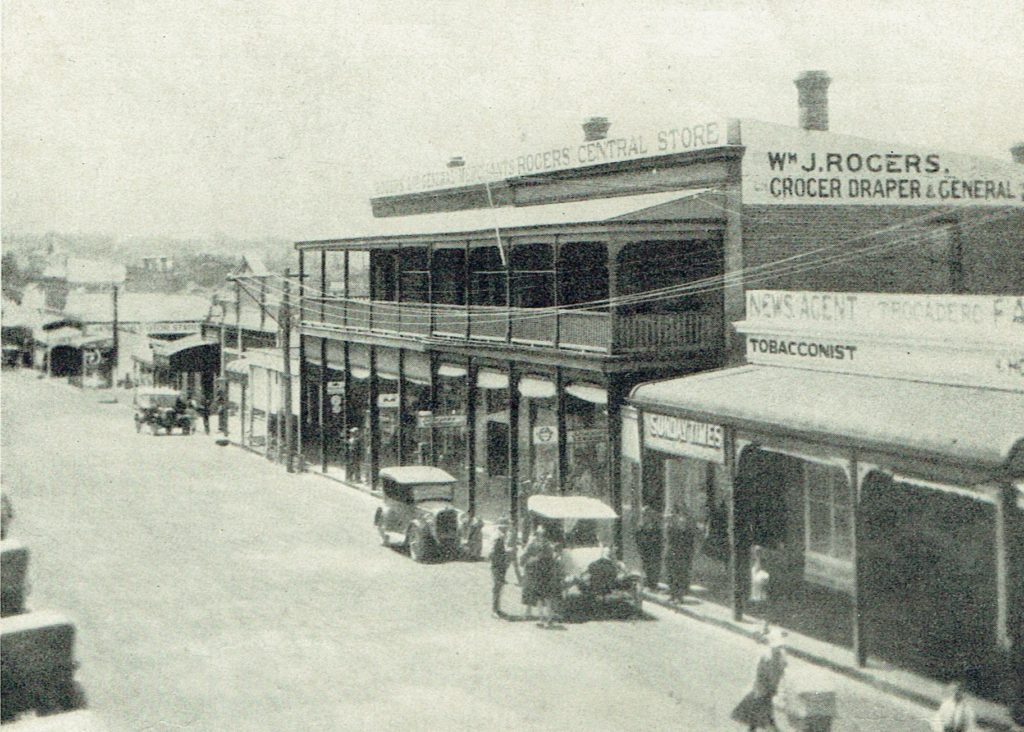
Roger’s Central Store in Clive Street c1910
Mr. Harris must be given the credit of initiating a policy of building a number of brick business premises and dwellings marking his enterprise. The first butcher was E. R. Beeck who, in 1898, was bought out by the late W. M. Baker, the business being continued at the death of the latter by his brother, Mr. S. J. Baker, for and on behalf of the executors.
Amongst the farmers who left South Australia for Western Australia were the Beecks, who arrived in 1892. Most of the members of this large family selected land in the vicinity of the town, but Mr. Paul A. Beeck preferred to set up as a saddler and harness maker in a small building in Clive Street. It is interesting to note that Mr. Beeck not only was the first saddler, but also dentist, barber, veterinary surgeon, and watchmaker, being the only representative of these various trades and professions for a number of years.
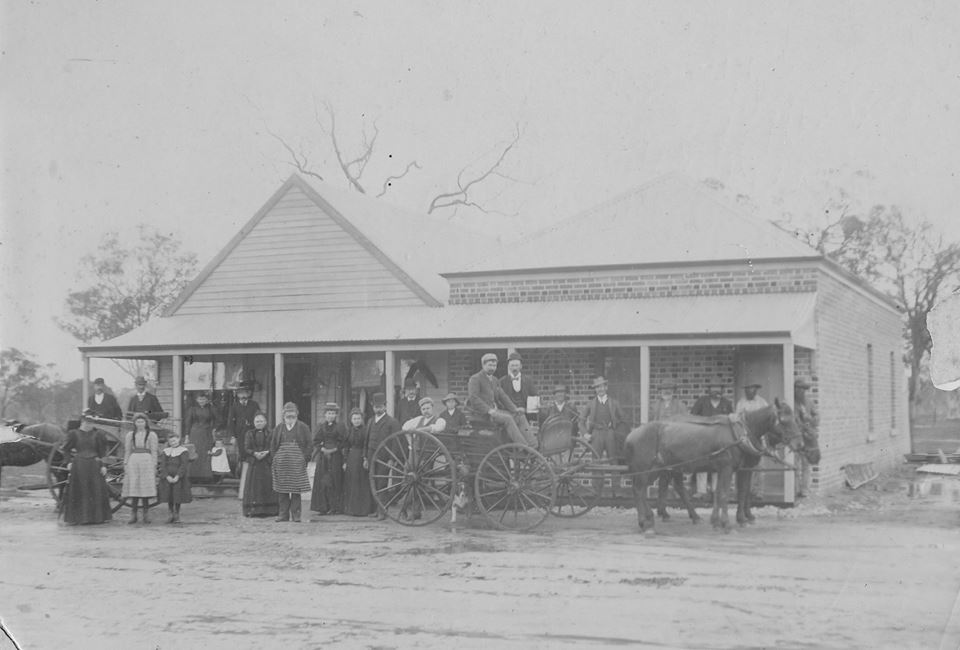
E.R. Beeck’s butcher shop and P.A. Beeck’s saddlery shop in Clive Street – 1896
Although the first hotel was built by F. H. Piesse in 1889, a second license was granted shortly afterwards to Mr. Richard Bell, to be known as the Railway Hotel, and later, renamed Royal Exchange Hotel, and carried on by him for some years until he sold the business and joined his sons on their property at Marracoonda.
About the same time the freehold of the Katanning Hotel was bought by Geo. McLeod, who had returned after an absence of some years on the Goldfields, and became a prominent figure in the business life of the town. Within very few years of the time that the Katanning Mill was in operation, the town was supplied with electric light and power from its power plant, Katanning being the first town in the State to be electrically lighted.
The first church to be built in Katanning was the old Roman Catholic Church, erected in 1891. This edifice served until 1926, when a fine modern structure was erected on a higher elevation in the town. St. Andrew’s Church was erected by the Anglican community in 1898, to be followed by the Baptist, Methodist, Presbyterian and Lutheran Churches. In 1928, the Salvation Army built a fine hail to serve as a place of worship for that body. The first newspaper, the “Great Southern Herald“, was established in 1901.
TOWN & DISTRICT
The District
Katanning, situated 225 miles from Perth and 115 miles from Albany, on the Great Southern Railway, is the centre of one of the most progressive and prosperous districts in Western Australia. Reaching west into the fertile clover belt of the Kojonup district and east to the wheat lands of Pingrup and Gnowangerup, the area embraces a variety of country, from dairying and fat lamb growing on the one side to the wheat and wool farming on the other, and every phase of mixed farming between.
The rainfall averages from 15 inches in the eastern portion to 29 in the western, Katanning itself having an average of 18 inches. Within its boundaries are the substantial centres of Woodanilling, Katanning, Broomehill, Tambellup and Cranbrook on the main line, Kojonup, Muradup, Boscabel, Jingalup, Dinninup and Tunney, in the clover belt on the west, and Gnowangerup, Borden, Ongerup, Badgebup, Nyabing and Pingrup, in the wheat growing areas of the east, comprising in all over 10,000 square miles of well-developed country.
Although the first railway – the Great Southern – was not completed until 1889, the district is now served by many miles of branch lines, radiating west to the western coast and east to the fringes of settlement. Running west, the Kojonup-Boyup Brook line connects with the main western line, and links Katanning to Bunbury and Busselton, on the western coast.
On the east, the Nyabing-Pingrup branch line extends direct from Katanning 70 miles into the great eastern wheat-belt, while a second branch line, leaving Tambellup, 25 miles south of Katanning on the Great Southern Railway, extends east to Gnowangerup and Ongerup, and taps the wheat-belt at its southern extremity, some 40 miles due south of Pingrup.
Extensions are under consideration by the Government from Pingrup to Magenta, 40 miles, and from Ongerup to Needilup, 25 miles further eastward, leaving a short section only to connect with Ravensthorpe and Hopetoun on the southern coast. Construction has been authorised of a line to connect Boyup Brook and Cranbrook, through the clover lands, on the west.
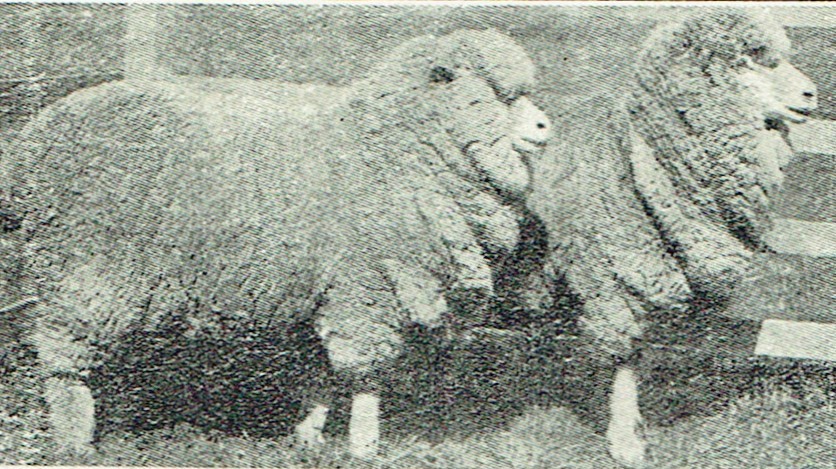
A pair of stud rams sold in Katanning in 1928.
Whilst the district has become recognised as the foremost in the State for merino sheep breeding and the growing of the famous “blue” wools, it also ranks high in the production of cereals and hay, and the returns from dairying and poultry are very considerable. The harvest for the 1927-28 season included 1,953,481 bushels of wheat, 687,047 bushels of oats, 18,610 bushels of barley, and 44,644 tons of hay, while 39,887 acres of land bore fodder crops, the wool clip for that year totalling 8,122,938 lbs.
The gross value of production for the 1927-28 season was estimated at £1,500,000, of which poultry accounted for £11,000. Livestock, as on December 31, 1928, numbered 13,588 horses, 11,143 cattle, 1,060,870 sheep, and 4,213 pigs. The population of the district is estimated to exceed 15,000.
Katanning
From the six wood-and-iron buildings of 1890, Katanning in forty years has grown to be the finest country town in the State. A re-valuation made by the Katanning Road Board in June, 1929, places improvements in the shape of buildings at £400,000, the capital value of town property being £500,000, with an annual rateable value of £30,000. These valuations are very conservative, as the buildings include 600 dwellings and the fine business premises of the two main streets.
The actual value of buildings erected during the year 1927-28 was £45,096, and for 1928-29, £22,631, and the estimated capital value of the town is £750,000. The town has its own water supply, a gravitation service from a 30,000,000-gallon reservoir on rising ground about three miles distant. The scheme, which cost £25,000, has become inadequate, and active steps are in progress to provide increased storage.
Electric light and power are obtained from the Katanning Flour Mills, which has a large power station, in addition to one of the finest milling plants in the State. Local government is in the hands of the Katanning Road Board, which also acts as the Local Health Authority and Water Board.
Three stock firms operate in the district, stock sales being held practically every week in Katanning, and at monthly intervals at all the principal centres. Five private banks, in addition to the State and Commonwealth Savings Banks, are established in the town.
Government buildings include Court House and Police Offices, Lands and Savings Bank Office, and a large Post Office and quarters, in addition to numerous buildings of the Railway Department. Two medical practitioners are in residence, and there is a commodious private hospital in addition to the large Government institution. Three hotels and two hostels provide accommodation for travellers.
The Katanning Club, established in 1912, possesses a fine property and is a popular, though exclusive body. Including the Town Hall, there are five large halls in the town, two of which are provided with stage and other facilities for entertainments. The six churches represent a capital expenditure of £16,000.
The chief secondary industries comprise the Katanning Flour Mills Ltd., the B.C.D. and Piesse Aerated Water Factory and the manufacture of self-raising flour, by Mr. A. G. Hobbs. As an important railway junction, the Railway Department has established locomotive sheds and yards, and retains a large staff at Katanning, to serve the branch lines to Donnybrook, Pingrup and Gnowangerup and Ongerup, as well as being a change station for the main Perth-Albany line.
The wonderful climate of the district has been a recognised factor in the establishment of schools at the town, which now possesses three private institutions – the Church of England Girls’ School, the Katanning Grammar School for boys, and a Convent School – in addition to the Government School, the latter with an average attendance of over 400 scholars.
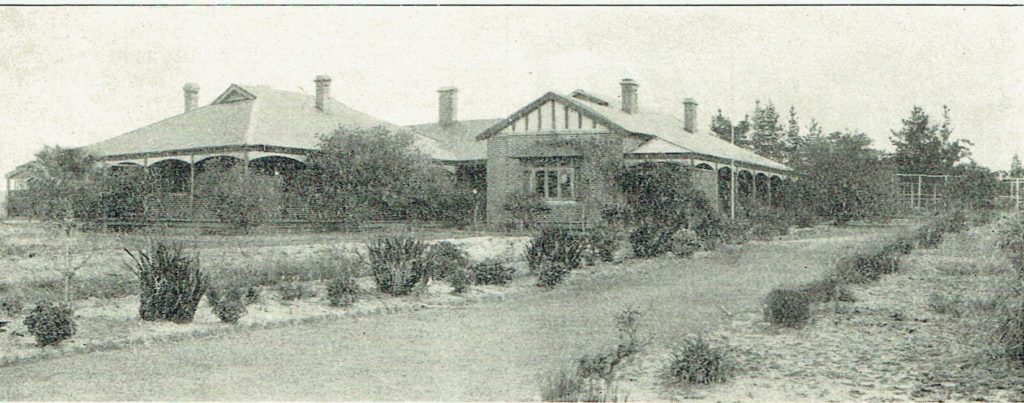
Katanning Boys Grammar School in Beaufort Street.
It later became ‘Coleraine Private Hospital’ and is now a private residence.
The capital expenditure on the four schools represents about £50,000. Sport is a great factor in the social life; golf, tennis, football, bowls, hockey, rifle shooting, cricket, polo, racing and trotting occupying their place in turn during the year.
.
PROGRESS OF KATANNING
& THE GREAT SOUTHERN
1922
While visiting Katanning recently I was afforded a good opportunity of seeing something of the wonderful progress made in recent years in these earlier settled districts of the Great Southern, and, when one looks at big thriving towns like Katanning and Wagin, the influence of individual families on this development will be recognised.
The late Messrs. F. and C. Piesse did much in laying the foundations for the trade, industry and general production of these two districts, and the members of their families are carrying on the good work.
Everybody in the Katanning district knows Mr. Harold Piesse, and as he also knows everybody. I was fortunate in having his guidance and agreeable company. The district, of which Katanning is the centre, embraces an area of country exceeding 10,000 square miles, in which are the thriving townships of’ Kojonup; Woodanilling, Nyabing, Badgebup, Broomehill, Gnowangerup, Ongerup, Tambellup and Cranbrook, and the population of 12,000 is rapidly increasing. Nearly four million acres in the district have been purchased by the Crown, of which 550,000 acres have been brought under cultivation, and 900,000 acres are in course of preparation for the plough. The harvest for the1920-21 season included 682,738 bushels of wheat, 412,162 bushells of oats, 10,000 bushels of barley and 27,676 tons of hay, whilst nearly 32,000 acres carried fodder crops.
The wool output totalled over four million pounds in weight, and the livestock statistics for the district show that this area of country accounts for 14,329 horses, 9,127 cattle, 659,943 sheep, and 3,531 pigs. lt will be seen from these figures that the district is highly productive now, but, when many of the farmers in the district improve their methods of working the land, the position will be greatly improved. The soil over a big range of this country is suitable for any class of production, and, with a rainfall that varies from 24 inches in the western and southern portions to 18 ” inches in the eastern areas, great things should be possible. Continue reading
PIONEER SHEEPMEN
West Australian
18 June 1937
The early history of the lower Great Southern, and the development of settlement in the Katanning, Kojonup and Broomehill districts, was outlined by Mr. L Synnott in a paper read before a recent meeting of the Katanning branch of the West Australian Historical Society.
After describing briefly, the early exploration northward from the settlement at King George’s Sound, Mr. Synnott said that in 1834 the Government Resident at Albany (Sir Richard Spencer) obtained 292 sheep from Tasmania. This flock was first depastured near Albany, but in 1835 was moved to a property on the Hay River, where Sir Richard had acquired Crown Land. Three years later Captain John Hassell selected 20,000 acres in the Mt. Barker district and named the property Kendenup. Some years later Captain Hassell extended his activities to Jerramungup, where he took up another large tract of land.
The first mention of Kojonup, he continued, was in 1837, when Surveyor Hillman and Dr. Harris explored the country in the vicinity of where the town of Kojonup stands today, the locality receiving its name from a spring of fresh water where they camped. Eleven years later, in 1848, Surveyor-General J. S. Roe, starting from York, explored the country southward to Cape Riche, his route being to the eastward of the present Great Southern railway. Reaching the coast, he turned eastward, traversing and naming the Pallinup, Gardiner. Fitzgerald and Phillips Rivers. He located large areas of sandalwood on this trip, a discovery which hastened, to some extent, the opening up of the Great Southern. That same year the survey of the Perth-Albany-road was completed, although the actual clearing did not commence until two years later.
Dealing with the construction of the Perth-Albany-road, Mr. Synnott said that it was from the military escorts in charge of the convict gangs that many of the early settlers in the lower Great Southern came. While the road was still in the making settlement was gradually extending northward from Albany. In 1839 Lieutenant Egerton Warburton, a son-in-law of Sir Richard Spencer, took up the St. Werburgh property to the west of Mt. Barker, and the property was still held by his descendants. Edward May Spencer, a son of Sir Richard, who had worked his father’s Hay and Mt. Barker properties, extended much further northward, and by 1840 he was the registered holder of land at Eticup, near Broomehill. His holding included at least portion of the old Goblup Estate, and on his death the land was divided between his nephew, Joseph Spencer, and his niece, who afterwards became Lady Cockburn Campbell. The first residences on Goblup was built by Lady Cockburn Campbell in 1873, and was in use when s the property was purchased In 1888 by Lord Brassey, and later when Messrs. Ross and Tom Anderson became owners in 1903.
THE SPENCERS’ OF ETICUP
The first surveys in the Kojonup district were made by Surveyor Hillman in 1840. In those days the Kojonup district embraced portions of the Katanning and Broomehill districts, and the first settler, apart from those connected with the military post in the town of Kojonup, was Edward May Spencer, of Eticup. The only other landholder near Eticup was a settler named Solomon Drolf. Joseph Spencer held 70 acres at Balgarup on the Perth-Albany-road about 10 miles south of Kojonup. For many years these three formed the vanguard of the pioneer sheepmen of the Great Southern who entered from the south.
To the north, however, Elijah Quartermaine, who left England with his family in 1830 to try his fortune in the new world, had taken up a small block at Yowangup Spring, some distance north-west of where Katanning stands today. The land had been selected purely as a sheep camp, and for the next 20 years Quartermaine was content to travel flocks of sheep yearly from Beverley southward, lambing at Yowangup and returning to Beverley for shearing.
From 1840 until 1880 practically no further settlement took place in the vast expanse of country east of the Perth-Albany-road between Beverley and Albany. In time a horsepad, winding from settler to settler, was worn between Beverley and Albany, touching in its windings Yowangup Spring, Catenup Pool (now Katanning), Eticup, and on down the Gordon River to Lake Matilda and Mt. Barker. In addition to the Perth-Albany-road and the Great southern track, a third route was opened up through the South-West, the track reaching down from Perth, along the Vasse, thence across country via Hesters to Kojonup. It was along these three routes that the first land settlement took place.
EXPLORATION BY SHEPHERDS.
Although much of the early exploration was done by sandalwood cutters, there was another and earlier channel of exploration – the shepherds from the more settled areas constantly pushing out in search of fresh pastures. When good pastures and water were discovered the early “sheep kings” would select small blocks around the waterholes. The shepherds also followed the example of their employers and selected land, and in this manner came many of the earliest settlers in the Katanning and Kojonup districts.
By 1870, however, there were still very few settlers in the lower great southern apart from sandalwood cutters and kangaroo hunters. The chief settlers then were the Quartermaines, Haddletons, Andrews’, Grovers and Cronins in the vicinity of Katanning, the Trimmers and Grahams of Eticup, the Treasures of Martinup, and the Norrishs’, Spencers, Jones’, Elverds and Baggs, of Kojonup. During the next 10 years only 50 new blocks were surveyed in the district, many of them for settlers already resident there. Among the newcomers, however, were the Annice’s, Alex Moir and Pat Garrity at Broomehill, and Michael Fahey at Gracefield on the Perth-Albany-road. This holding was subsequently taken over by James Tunney, son of Sergeant Tunney, of Albany, and it was still held by the Tunney family.
Concluding with a reference to the building of the Great Southern railway, Mr. Synnott said that construction was carried on simultaneously from the Beverley and Albany ends and the linking up took place at Katanning in 1889. It was in that year that the Piesse brothers, Charles and Frederick, who had followed the construction gangs as storekeepers, decided to open a business in Katanning. With the coming of the railway Katanning received its first big impetus and progress had been steady ever since.
NAMING KATANNING.
West Australian
20 November 1937
To the Editor.
Sir,
I was interested to read a letter from F. North, of South Bunbury, saying that Katanning was named after Kate Annie, a native woman who died here about 50 years ago. Your correspondent prefaced this theory with the statement, “I read in ‘The West Australian’ recently an account of how Katanning got its name, but I have my doubts about its being correct.”
Assuming that he refers to the information published from Mr. J. F. Haddleton, of Katanning, which stated that the name originated from the native name for a camping place, located on the site of the present town park (Kart-annup), I can only say that Mr. North is sadly misinformed. Mr. Haddleton’s version has the concurrence of the Katanning Branch of the Western Australian Historical Society.
Mr. North has quoted a popular fallacy, which although rather romantic, has been blown out of existence by research, backed up by such authorities as the late Mr. Arnold E. Piesse, M.L.A, Mr. Eli Quartermaine, and Mr. Haddleton himself, who was born and bred in the Katanning district.
I have in my possession some memories of earlier Katanning in the handwriting of the late Mr. Arnold E. Piesse, M.L.A., concerning the origin of the name he states: “Katanning was not named after ‘Kate Annie’ or ‘Kate Anning’ as many people imagine, for that good native woman died some years after the name was in common use. It may have been that she was named after Katanning. The name of our town came from the native term ‘Kartanup,’ a site in our present park.”
Mr. Piesse then proceeds to give the same explanation as that given by Mr. Haddleton. I might add that Mr. Haddleton’s information was not published before considerable research had been put into it.
Yours, etc.
HERZEL W. BAKER,
Hon. Research Officer,
Katanning Branch W.A. Historical Society.
Early History. Early History. Early History. Early History. Early History. Early History. Early History. Early History. Early History. Early History. Early History. Early History. Early History. Early History. Early History. Early History. Early History. Early History. Early History. Early History. Early History. Early History. Early History. Early History. Early History. Early History. Early History. Early History. Early History. Early History. Early History.
Early History
